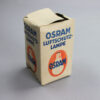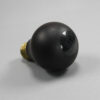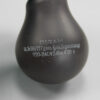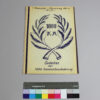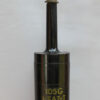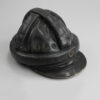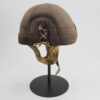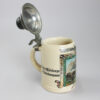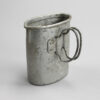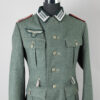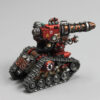Air protection lamp
Inventory number: DPM 5.15
A black light bulb, only a narrow beam of light penetrates through a small hole. This lamp from the Osram company looks strange and had only one purpose: to illuminate a room with as little light as possible; no ray of light was allowed to penetrate out to the sides.
Every night-time glow of light gave Allied bomber pilots in the Second World War clues as to the position of residential and industrial areas. The hope that an effectively darkened city would literally disappear for the pilots only worked at the beginning of the war. From 1943, British bombers were equipped with radar systems, which made the attacks less dependent on visibility.
The air protection measures, which in addition to darkening the light sources also included covering windows and setting up private air-raid shelters, had to be financed and carried out by the citizens themselves. Many felt that they were laborious and that the privatization of the burden of war was unfair.
At the beginning of the war, the Nazi leadership assumed that improvised air-raid shelters in basements would suffice; the construction of public bunkers began too late.
The brochure “Luftschutz – anschaulich gemacht!” (“Air protection – made clear!”) published by the Reichsluftschutzbund in 1940 states: “Anyone who darkens badly is a traitor and a saboteur!” Local NSDAP groups were on patrol and checked that the windows were properly darkened. Negligent citizens were pilloried with public posters or fined.
Anyone who made mistakes in blacking out could be sentenced to prison or even executed under the newly introduced “Ordinance against Pests of the People”. The ordinance was actually intended to punish crimes committed under cover of darkness during air raids and thus give the population a greater sense of security. However, in addition to the looting of bomb-damaged houses, the ordinance was increasingly used to repress the population and even minor offenses were punished disproportionately.
The Nazi leadership also saw successful air raid protection and thus less destruction from Allied bombing raids as a guarantee of the population’s support for the war. The experience of the bombing intensified criticism of the conduct of the war and damaged confidence in the government. However, there was no uprising, as hoped for by some military officers and politicians on the Allied side.
Object of the month
(short) stories from the depot
Unfortunately, many objects cannot currently be shown in the exhibition for conservation reasons. Here you will find unusual objects and exciting stories of special pieces from the depot


